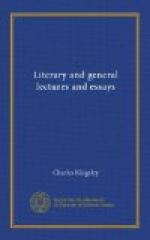We by no means agree in the modern outcry for “originality.” Is it absolutely demanded that no poet shall say anything whatsoever that any other poet has said? If so, Mr. Smith may well submit to a blame which he will bear in common with Shakespeare, Chaucer, Pope, and many another great name; and especially with Raphael himself, who made no scruple of adopting not merely points of style, but single motives and incidents, from contemporaries and predecessors. Who can look at any of his earlier pictures, the Crucifixion for instance, at present in Lord Ward’s gallery at the Egyptian Hall, without seeing that he has not merely felt the influence of Perugino, but copied him; tried deliberately to be as like his master as he could? Was this plagiarism? If so, all education, it would seem, must be a mere training in plagiarism. For how is the student to learn, except by copying his master’s models? Is the young painter or sculptor a plagiarist because he spends the first, often the best, years of his life in copying Greek statues; or the schoolboy, for toiling at the reproduction of Latin metres and images, in what are honestly and fittingly called “copies” of verses. And what if the young artist shall choose, as Mr. Smith has done, to put a few drawings into the exhibition, or to carve and sell a few statuettes? What if the schoolboy, grown into a gownsman, shall contribute his share to a set of “Arundines Cami” or “Prolusiones Etonienses?” Will any one who really knows what art or education means complain of them for having imitated their models, however servilely? Will he not rather hail such an imitation as a fair proof, first of the student’s reverence for authority—a more important element of “genius” than most young folks fancy—and next, of his possessing any artistic power whatsoever? For, surely, if the greater contains the less, the power of creating must contain that of imitating. A young author’s power of accurate imitation is, after all, the primary and




